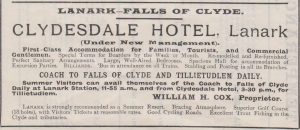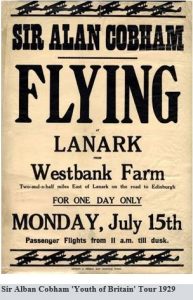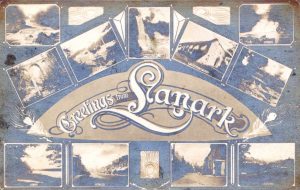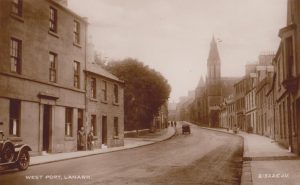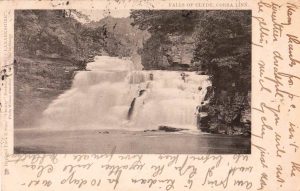Lanark
William Wallace murdered Haselrigg, the English Sheriff of Lanark at the town’s Castle in May 1297. The reason for this act is the subject of dispute. Regardless of why, this single act set Wallace on the path to his destiny; it brought him the support of much of the population, and galvanised ordinary Scots to rally to his flag.
Lanark’s name comes from its woollen industry (from the Norman French, the modern ‘laine’, meaning wool, is related to it); indeed Edward I’s tax on wool in 1296 (to finance a campaign in Flanders) inflamed local opinion and garnered Wallace much local support. The town had a Greyfriars monastery, founded at the time of Robert the Bruce, it was located between Broomgate and Friars Lane. The site of a house reputed to have belonged to Wallace lies opposite the church of St Nicholas at the west end of the High Street (above the door of which a statue of Wallace was placed in the early 19th Century).
An interesting remnant of the period can be found in the rear of one of the properties in the High Street, from Bernards Wynd a 13th Century gothic window can be seen; this was from a stone-built house, probably owned by the monks of Dryburgh (being the best house in the Town, it is likely that Wallace resided there after his defeat of the English forces at Stirling Bridge). In the grounds of Lanark’s old cemetery are the remains of the original St Kentigern’s Church, the south wall and chancel arch are from Wallace’s time.
Narrow by year:
Narrow by tags:
Samuel Forrest Family Butcher advert
documentAn advert for Samuel Forrest Family Butcher from around 1910. Samuel Forrest was Provost of Lanark in 1910 and seems to have had a good butchery business considering he had…
Clydesdale Hotel advert
documentAn early 20th-century advertisement for the Clydesdale Hotel, Lanark. At this time, it was considered to be the best hotel in Lanark. The Cartland was, at that time, a private…
Sir Alan Cobham, Youth of Britain Tour
documentSir Alan John Cobham, KBE, AFC (6 May 1894 – 21 October 1973) was an English aviation pioneer. In 1929 Cobham mounted his first tour of Britain, called the Municipal…
Robert McCall, Carriage Hirer
documentAn advertising document produced for Robert McCall, a carriage hirer based in Lanark. McCall’s likely operated from the Victoria Hotel/Royal Oak Hotel, with most trips being to the Falls of…
Lanimer Procession
postcardThis card showing the Lanimer Procession in 1905. This card is interesting in that it records that the picture was taken by Rogers and Co at 98-100 High Street, Lanark.…
Lanimer Morning Procession
postcardThis photograph was taken by the firm Rogers & Co photographers of the Lanimers in 1906. This card was then posted to John Wardrop of Shellburn in Sullivan County, Indiana.
High Street, Lanark
postcardThis is a photo of Lanark High Street from about 1912. The public toilet is visible. These underground toilets were situated near Lanark Tolbooth. It is thought that these were…
Multicard of Lanark
postcardFeaturing many different views of various attractions in Lanark. This is an early example of the multicard type of postcard. It was not a great success as many of the…
West Port, Lanark
postcardThis is a view of the West Port which was posted on July 18th 1933. The writer of the card sent separately four stockings to Miss Ruby Aitken of Knowhead,…
Falls of Clyde, Corra Linn
postcardIn the early years of the 20th century, the message on a postcard was written on the front of the card, with the reverse reserved solely for the recipient address…
